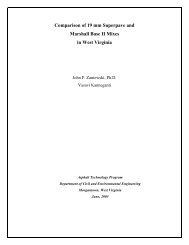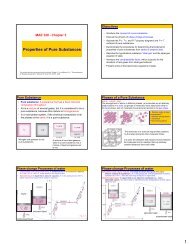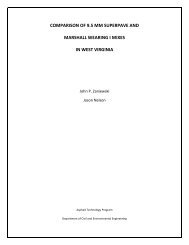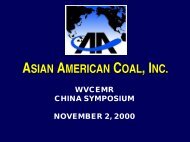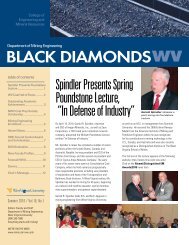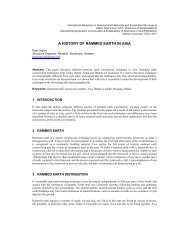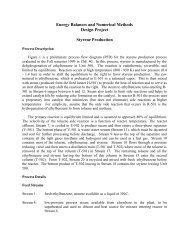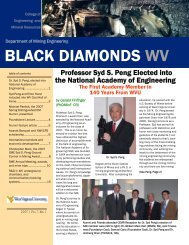FTIR sampling technique - CEMR
FTIR sampling technique - CEMR
FTIR sampling technique - CEMR
You also want an ePaper? Increase the reach of your titles
YUMPU automatically turns print PDFs into web optimized ePapers that Google loves.
Selection rule for infrared spectroscopyprerequisites for Infrared activeQuantification of Infrared AdsorptionThat is, the molecules can interact with light and lead to infraredabsorption only when all the following requirements are met:1) The frequency of the infrared light must be identical to the frequency ofthe vibration (resonance).Absorption is quantized, Different bonds absorb different units of E2) The dipole of the molecule must change during vibration.3) The direction of the dipole change must be the same as the direction ofthe electric filed vector.Acquisition of infrared spectraFormat of IR spectraInfrared Spectra of materialsTransmission spectrumWavenumber (cm -1 )Adsorption spectrumWavenumber (cm -1 )Adsorption bands in IR spectraInterpretation of infrared spectra1) Single-bond regime: assign peaks between 3300 and 2800 cm -12) Double bond regime (1750-1500 cm -1 )3) Triple bond regime (2300-2100 cm -1 )4) identify major peaks in the finger print region (1500-600 cm -1 ),each type of compound has characteristic peaksMany bands & many overlaps– Heavy atom stretches.Stretching and bending vibrational modes for a CH 2 group,Leading to the bands (peaks) in the IR spectrum4) use IR databasehttp://en.wikipedia.org/wiki/Infrared_spectroscopy3
<strong>FTIR</strong> <strong>sampling</strong> <strong>technique</strong> -ATRAttenuated total reflection (ATR) infrared spectroscopy:At each reflection, the light beam penetrates the sample to a depth of a fewmicrons and is absorbed at the characteristic absorption frequencies. ZincSelenide (ZnSe) crystal is most commonly used for ATR accessory.<strong>FTIR</strong> <strong>sampling</strong> <strong>technique</strong> -ATREvanescent wave:• The defining feature of ATR spectroscopy is the presence of an evanescentwave. The evanescent wave is a special type of electromagnetic radiation• It is present only in the regime of supercritical internal reflection• It propagates parallel to the interface• Its intensity decreases exponentially with the distance from the <strong>sampling</strong>surface of IREPenetration depth• Its penetration depth is on the order of wavelength• Intensity of Evanescent wave decreases exponentially with the distance• The penetration depth is a function of experimental parameters, forexample, it is dependent upon the sample material<strong>FTIR</strong> <strong>sampling</strong> <strong>technique</strong> -ATRAttenuated total reflection infrared (ATR-IR) spectroscopy:• for thick films or bulk lump material with smooth surface• for materials which are either too thick or too strong absorbing to beanalyzed by transmission spectroscopy.• liquid samples• no sample preparation is required for ATR analysis.<strong>FTIR</strong> <strong>sampling</strong> <strong>technique</strong> – diffuse reflectanceAt each reflection, the light beam penetrates the sample to a depth of a fewmicrons and is absorbed at the characteristic absorption frequencies. ZincSelenide (ZnSe) crystal is most commonly used for ATR accessory.1) When the IR beam enters the sample, it can either be reflected off thesurface of a particle or be transmitted through a particle.2) The IR energy reflecting off the surface is typically lost.3) The IR beam that passes through a particle can either reflect off the nextparticle or be transmitted through the next particle. This transmissionreflectanceevent can occur many times in the sample, which increasesthe pathlength.4) Finally, such scattered IR energy is collected by a spherical mirror that isfocused onto the detector.5) The detected IR light is partially absorbed by particles of the sample,bringing the sample information<strong>FTIR</strong> <strong>sampling</strong> <strong>technique</strong> – diffuse reflectanceSpecular reflection versus diffuse reflection• Specular reflection: When an infrared beam is focusedon the surface of a particulate sample, it can interact withthe sample two ways. First it may simply reflect off thesample surface in the same way visible light reflect off amirror. This phenomenon, called “ specular reflection”, isa function of the refractive index of the sample.• Specular reflection is suitable for smooth surface thatcan strongly reflect IR beam.<strong>FTIR</strong> <strong>sampling</strong> <strong>technique</strong>: PM-IRRASPM-IRRAS:Polarization modulation infrared reflection adsorption spectroscopyp-polarized:Electric field lies in the plane formed byincident and reflected waves.For p-polarized light, the electric field has acomponent perpendicular to the surface and acomponent parallel to the surface• Diffuse reflection collects infrared radiation from the IRbeam that passes through a particle can either reflect offthe next particle or be transmitted through the next particle.This transmission-reflectance event can occur many timesin the sample, which increases the pathlength.• Diffuse reflection collects scattered IR energy,• Diffuse reflection is used for rough sample and particleassembly.s-polarized:Electric field lies perpendicular to the planeformed by incident and reflected waves.For s-polarized light, the electric field isparallel to the surface plane5
Principle of Raman spectroscopyThe basic set-up of a Raman spectrometer is shown below. Note that thedetector is orthogonal to the direction of the incident radiation, so as to observeonly the scattered light. The source needs to provide intense monochromaticradiation, and so is usually a laser.1) Raman spectroscopy collect scattered radiation.2) The criteria for a molecule to be Raman active are also different to othertypes of spectroscopy. Raman active does NOT require a permanentdipole moment.From Kiera JonesPrinciple of Raman spectroscopySelection rule for Raman active-- polarizabilityFor IR spectroscopy, it is necessary for the molecule to have a permanentelectric dipole. This is not the case for Raman spectroscopy, rather it is thepolarizability (α) of the molecule which is important.The oscillating electric field of a photon causes charged particles (electronsand, to a lesser extent, nuclei) in the molecule to oscillate. This leads to aninduced electric dipole moment, µ ind , whereµ ind = α EThis induced dipole moment then emits a photon, leading to either Raman orRaleigh scattering.The energy of this interaction is also dependent on the polarizability:Energy of interaction = -1/2α E 2The energies of Raman transitions are relatively weak. To counter this, ahigher intensity of the exciting radiation is used.For Raman scattering to occur, the polarizability of the molecule must varywith its orientation. One of the strengths of Raman spectroscopy is that thiswill be true for both heteronuclear and homonuclear diatomic molecules.Principle of Raman spectroscopySelection rule for Raman active-- polarizabilityIRRamani. vibrational modes vibrational modesii. change in dipolechange in polarizabilityPrinciple of Raman spectroscopySelection rule for Raman active-- polarizabilityIR spectroscopy:• Adsorption:(radiation at a certain frequency isadsorbed due to the resonance ofmolecular vibration)• observed peak is due tomolecular vibrationRaman spectroscopy:• scattered emission:(radiation at a certain frequencyis scattered by the molecule withshifts in the wavelength of theincident beam)• observed frequency shifts arerelated to vibrational changes inthe moleculeiii. excitation of molecule toexcited vibrational statemomentary distortion of theelectrons distributed around thebondhv 1hv 1Principle of Raman spectroscopySelection rule for Raman activeThe molecule is originally at the E 2 energy state. The photon interacts with themolecule, exciting it with an energy hν i . However, there is no stationary stateof the molecule corresponding to this energy, and so the molecule relaxesdown to the energy levels E 1 or E 3 . This process emits a photon in two ways:Anti-Stokes transition:If the molecule relaxes to energy state E 1 , it will have lost energy, and so thephoton emitted will have energy hν r1 , where hν r1 > hν iStokes transitions:If the molecule relaxes to energy state E 3 , it will have gained energy, and sothe photon emitted will have energy hν r2 , where hν r2 < hν iPrinciple of Raman spectroscopyFor rotational spectroscopy, both Stokesand anti-Stokes transitions are seen.For vibrational spectroscopy, Stokestransitions are far more common, and soanti-Stokes transitions can effectively beignored.rayleigh scatterFrom Clayton Butler7
Principle of Raman spectroscopySummary of the selection rules for Raman activeApplication of Raman spectroscopyConfocal Raman microscopy for three-dimensional imaging1) For Raman scattering to occur, the polarizability of the molecule mustvary with its orientation. (However, Raman active does NOT require apermanent dipole moment).2) For vibrational or rotational transitions, the total angular momentumquantum number for rotational energy states must be met.3) For rotational spectroscopy, both Stokes and anti-Stokes transitions areseen. For vibrational spectroscopy, Stokes transitions are far morecommon, and so anti-Stokes transitions can effectively be ignored.http://www.chemsoc.org/ExemplarChem/entries/2004/birmingham_jones/raman.html#Spectrahttp://www.kosi.com/raman/resources/technotes/1350.pdf8



